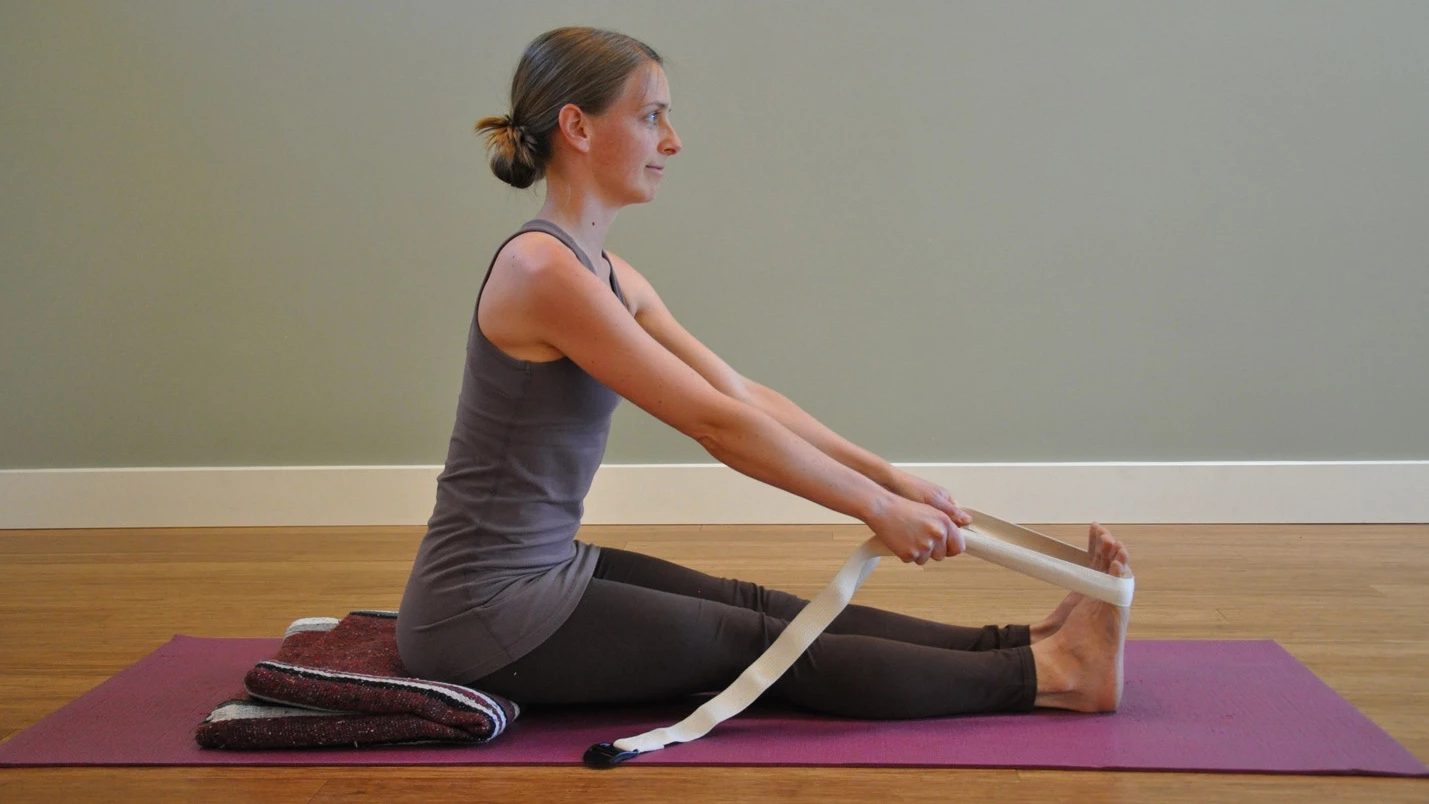Forward Bend With Ease

Even if you’re flexible, it’s not that easy to maintain your spine’s natural curves when you sit in Dandasana (Seated Pose). As with every pose, there are as many variations as to how Seated Pose will look as there are people. Dandasana, despite the fact that it looks simple, is challenging for almost everyone. At least, it’s challenging for almost everyone to practice it in a way that supports a healthy spine.
This is because it’s not actually natural to sit with your legs straight in front of you. No matter how bendy you are, practicing Dandasana with straight legs will probably not allow your spine to be in its natural curves. A more natural pose might be to bend the knees and separate the legs a bit.
However, if you want to practice Dandasana with straight legs for the hamstring experience that comes with it, a yoga strap and a yoga blanket can help keep your spine as upright as possible. As long as your sacroiliac joint and pelvis are initiating your forward bend—moving along with the rest of your spine—Dandasana can provide a healthy hamstring stretch.
Here’s how:
Sit on the floor with your legs stretched out in front of you. Reach back and feel your lower spine. If the spinous processes—the knobby protrusions on the back of each vertebra—are poking out into your back, this means that your lumbar is in a convex rather than concave curve. If you know your hamstrings are on the tight side, try sitting on a folded Yoga Blanket to help your pelvis tilt forward more easily, which will also allow your spine to find its natural curves more easily.
Check your lumbar spine again. You may still feel the spinous process poking out. If so, you can bend your knees a bit to allow your spine to straighten. Whether your knees are straight or bent, take a yoga strap and place it around the balls of your feet. Hold the strap with both hands and use it to help you bring your spine to upright. Stay upright in the pose rather than bending forward. Take five to ten deep breaths, grounding your sit bones as you lengthen your spine upward.
If you decide to bend forward from here, keep the strap taut as you bend forward. Make sure that your pelvis moves forward with the rest of your spine.
 Charlotte Bell began practicing yoga in 1982 and began teaching in 1986. She was certified by B.K.S. Iyengar in 1989 following a trip to Pune. In 1986, she began practicing Insight Meditation with her mentors Pujari and Abhilasha Keays. Her asana classes blend mindfulness with physical movement. Charlotte writes a column for Catalyst Magazine, and is the author of two books: Mindful Yoga, Mindful Life and Yoga for Meditators, both published by Rodmell Press. She also edits Hugger Mugger Yoga Products¹ blog and is a founding board member for GreenTREE Yoga, a non-profit that brings yoga to underserved populations. A lifelong musician, she plays oboe and English horn in the Salt Lake Symphony and the folk sextet Red Rock Rondo whose 2010 PBS music special won two Emmys.
Charlotte Bell began practicing yoga in 1982 and began teaching in 1986. She was certified by B.K.S. Iyengar in 1989 following a trip to Pune. In 1986, she began practicing Insight Meditation with her mentors Pujari and Abhilasha Keays. Her asana classes blend mindfulness with physical movement. Charlotte writes a column for Catalyst Magazine, and is the author of two books: Mindful Yoga, Mindful Life and Yoga for Meditators, both published by Rodmell Press. She also edits Hugger Mugger Yoga Products¹ blog and is a founding board member for GreenTREE Yoga, a non-profit that brings yoga to underserved populations. A lifelong musician, she plays oboe and English horn in the Salt Lake Symphony and the folk sextet Red Rock Rondo whose 2010 PBS music special won two Emmys.



